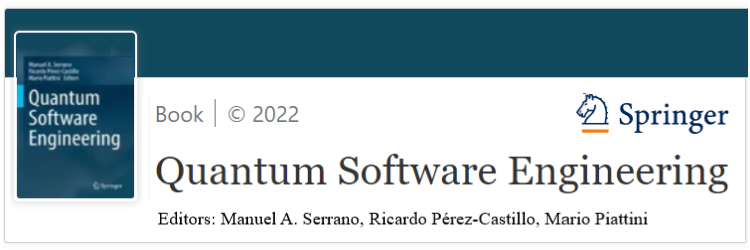Manuel Serrano, Ricardo Pérez del Castillo and Mario Piattini, members of aQuantum have edited in Springer the book “Quantum Software Engineering” in which several members of aQuantum participate as authors of different chapters.
It is worth highlighting the work of the Editors to ensure that the book has a marked accent on European thinking on Quantum Software Engineering, achieved through a logical and harmonious structure, which exposes the contributions of European researchers on Quantum Software Engineering and Programming from Spain (University of Alcalá, University of Castilla-LaMancha, University of Extremadura, University of Oviedo), Germany (University of Stuttgart), Israel (The Jerusalem College of Engineering), Portugal (University of Porto), United Kingdom (University of Kent, University of Oxford).
In addition, the book is complemented by applied research expertise and practical insight from two leading quantum software solutions and service companies, aQuantum (Spain) and Classiq Technologies (Israel), expressed through the characteristics of their platforms for the development of algorithms and quantum software: QuantumPath® and QAD, respectively.
In Chap. 2, Mario Piattini from aQuantum and Juan Manuel Murillo from UIMQ (Joint Quantum Software Research Unit aQuantum-UEx) present the quantum software engineering landscape and the main challenges that arise in this new computing paradigm. This chapter also briefly reviews the Talavera Manifesto for quantum software engineering and discusses the main problems in the field. In chapter 3, Miguel Blanco and Manuel A. Serrano propose a governance system adapted to quantum information systems, based on COBIT. In Chap. 8, written by David Valencia, Enrique Moguel, Javier Rojo, Javier Berrocal, Jose Garcia-Alonso and Juan M. Murillo from UIMQ, an approximation to the development of hybrid quantum-classical services is proposed using service-oriented architectures, in order to tap on problems hard to deal with classical computing algorithms. Antonio García de la Barrera, Ignacio García-Rodríguez de Guzmán, Macario Polo, and José A. Cruz-Lemus show, in Chap. 9, the current trends and emerging proposals for quantum software testing. Ricardo Pérez del Castillo and Luis Jiménez-Navajas present in Chap. 11 a software modernization process based on ADM, and, hence, on reengineering, which could be effective in situations resulting from the evolution of classical and quantum software.
Turning to the quantum software environments and tools, Chap. 12, by Jose Antonio Cruz and Manuel A. Serrano, presents an overview of the different quantum software layers and the existent quantum software tools and platforms; and Chapter 13, written by Guido Peterssen, Jose Luis Hevia and Mario Piattini shows QuantumPath® (QPath®), which is a state of the art quantum software development platform to support the design, implementation, and execution of quantum software applications.
The book’s editors insist that for quantum applications to be truly useful, they must be developed in accordance with Software Engineering best practices; and in fact the book gathers software engineering techniques and tools to improve the productivity ad assure the quality in quantum software development.
From aQuantum within the mission of quantum literacy that we set ourselves since our inception and in order to transmit the lessons and knowledge acquired over the years, we hope that this book can contribute to the production of quantum software with sufficient quality and productivity, which is the cornerstone for the dissemination of quantum software enginering.
The aQuantum Team congratulates all the authors for this publication and their contribution to the dissemination of Quantum Software Engineering.
You can see all the books, articles and other papers published by aQuantum here.


Recent Comments